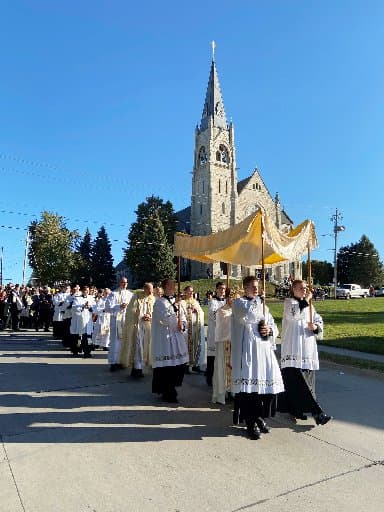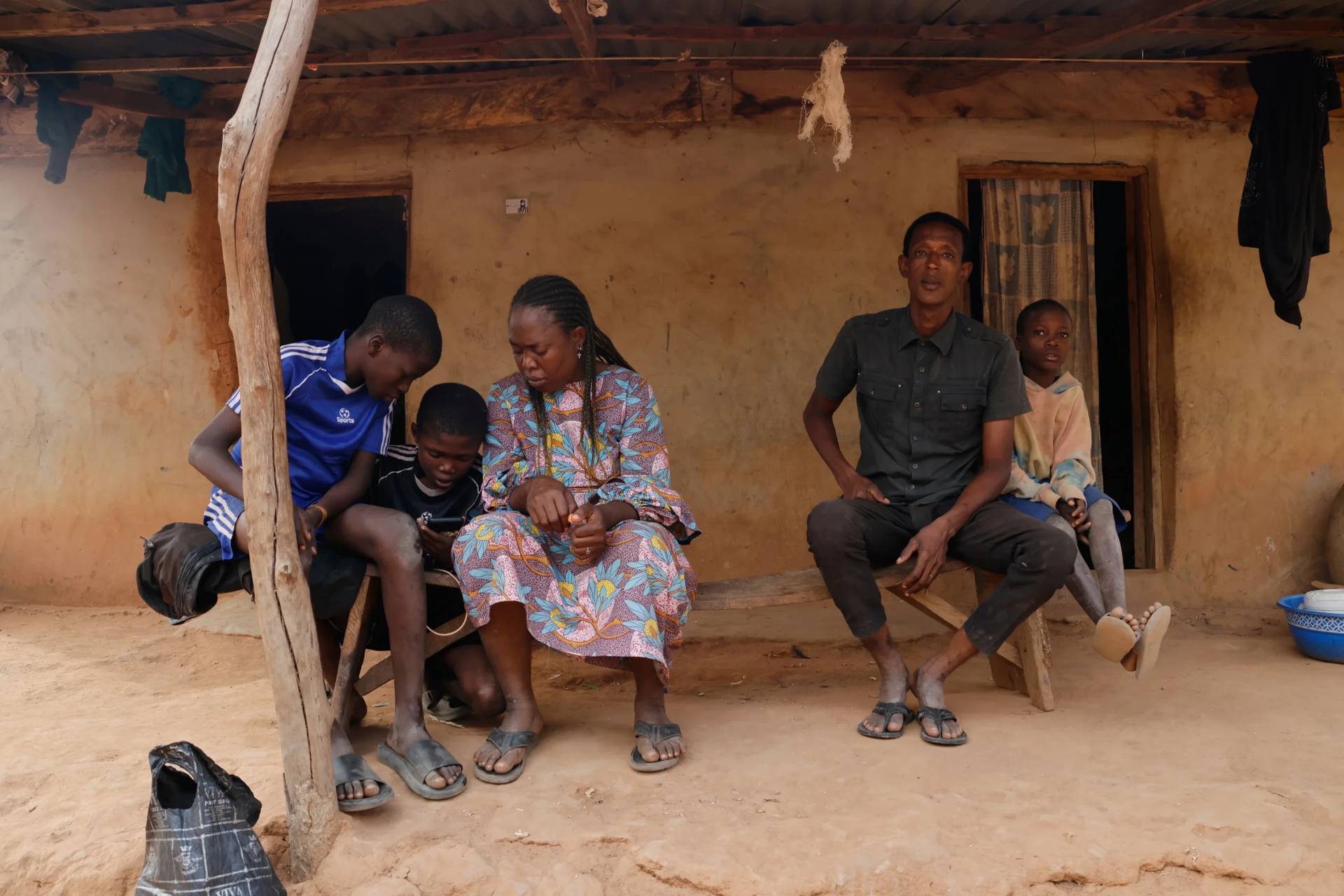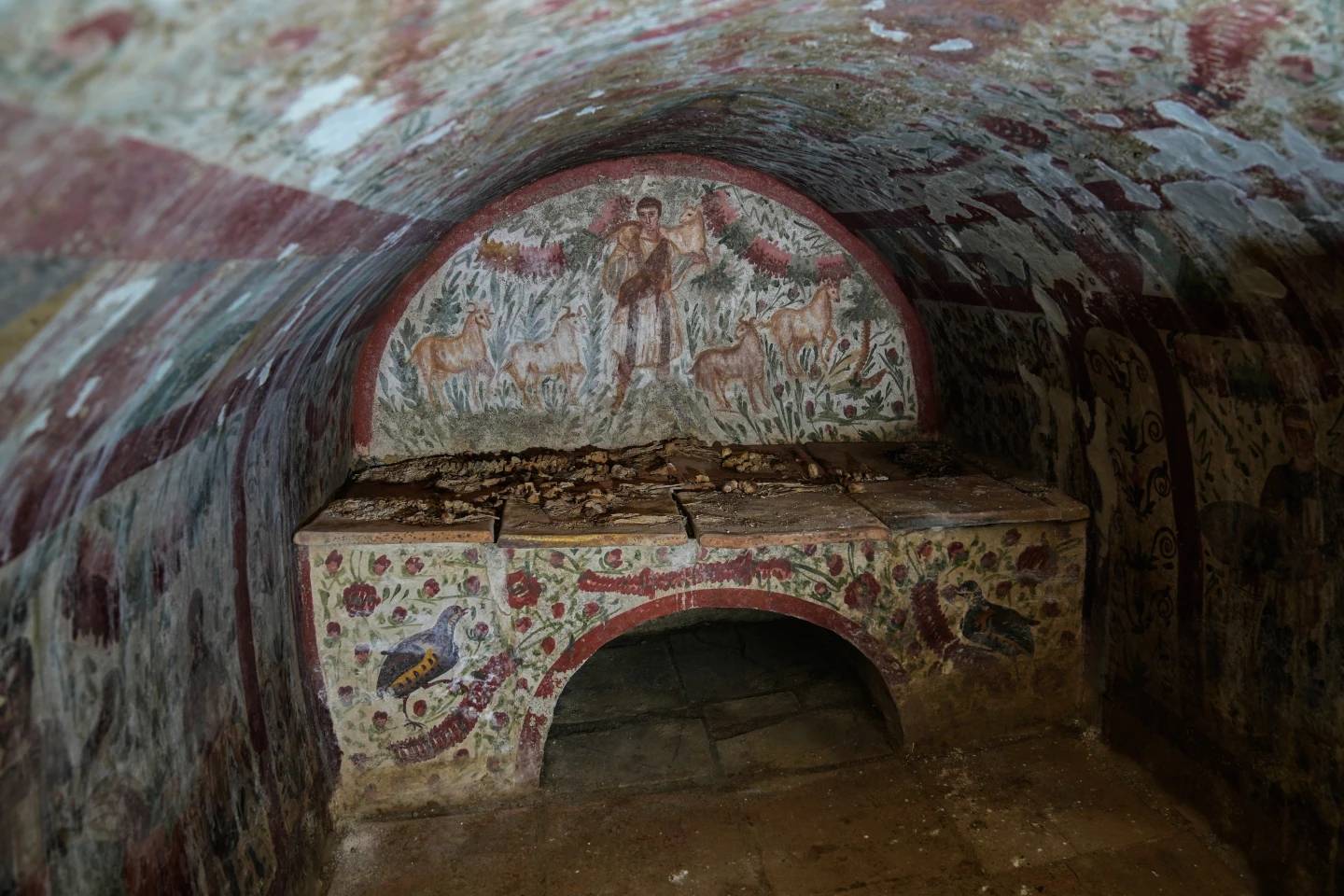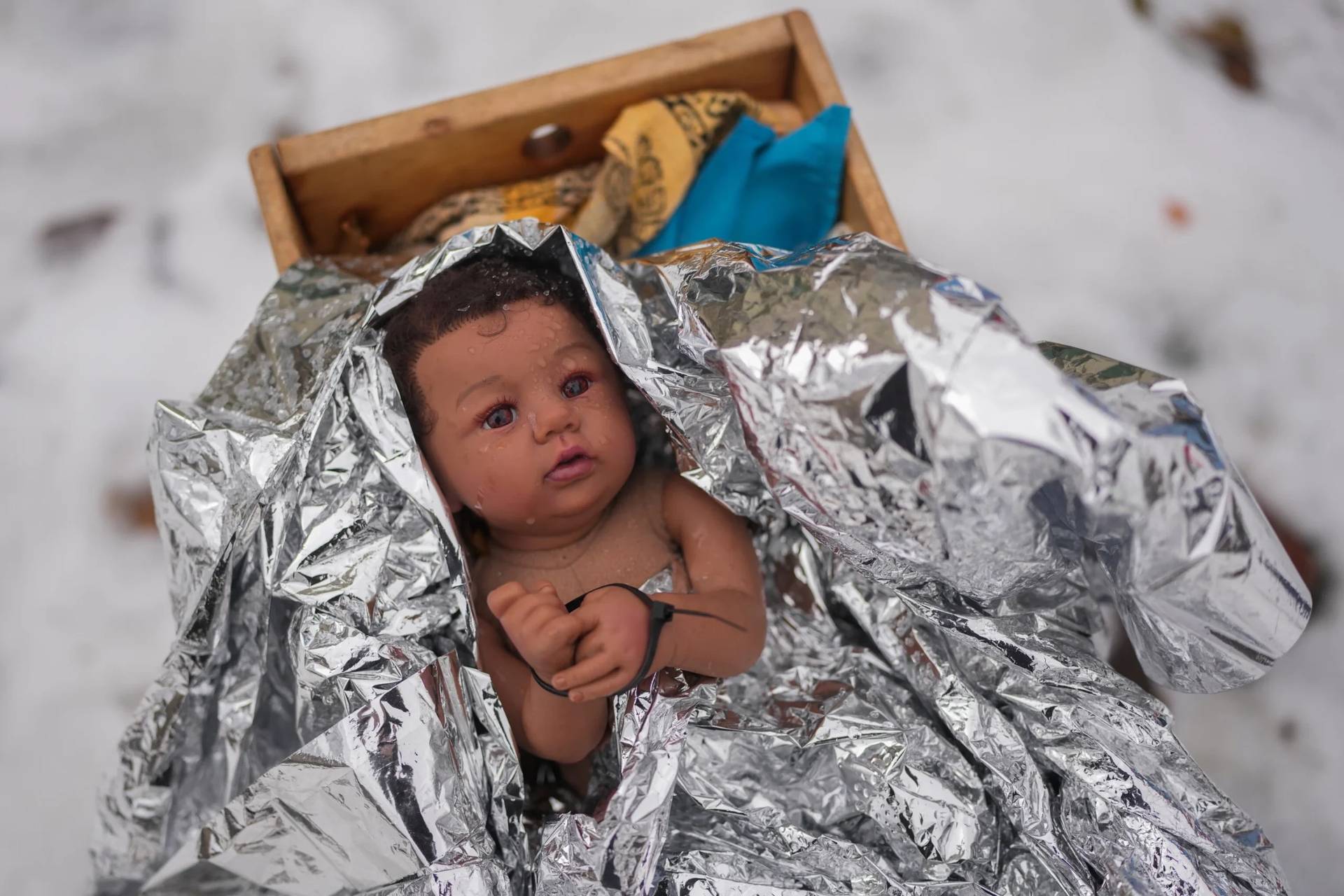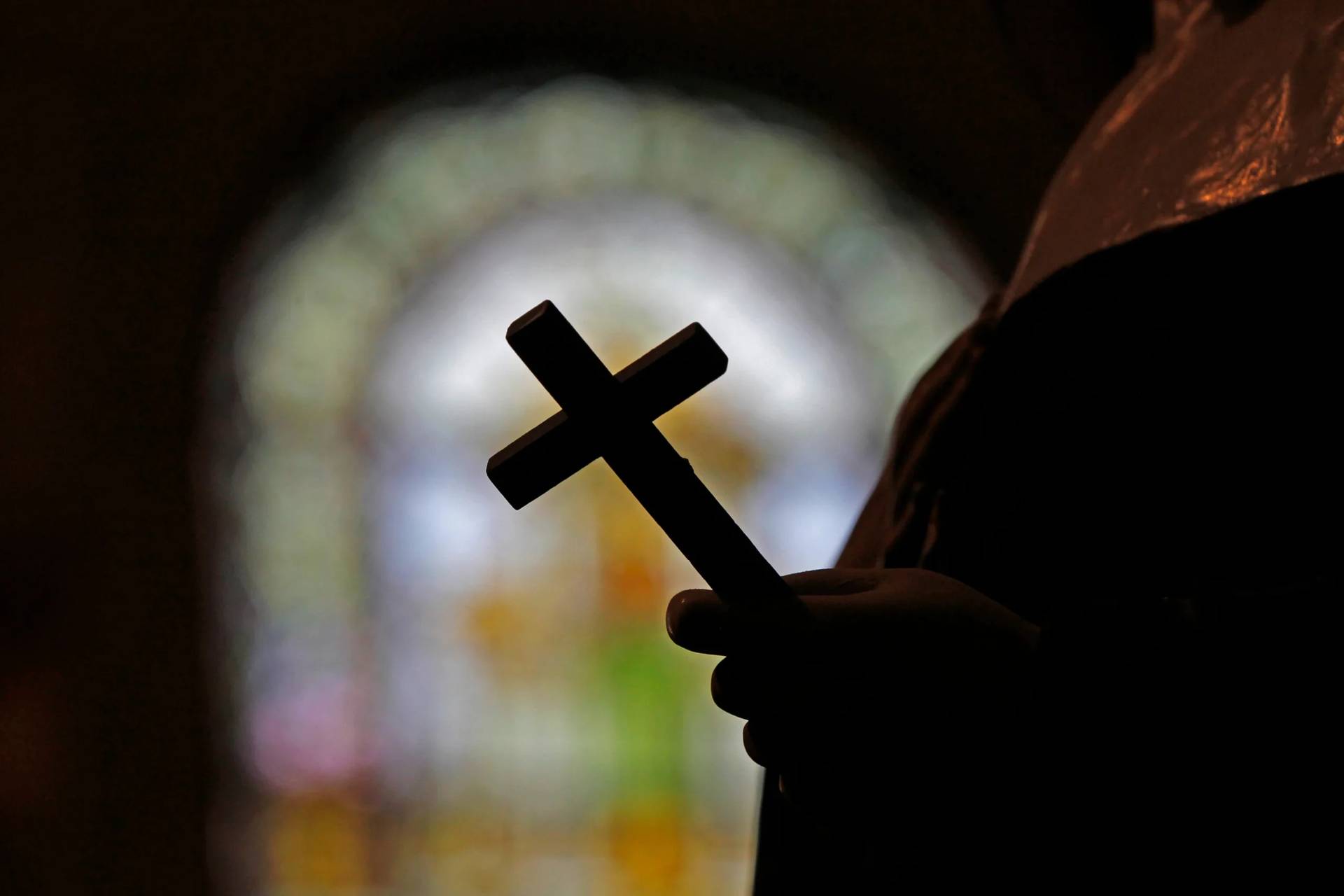Hundreds of Catholics, led by the bishops of the dioceses of Davenport in Iowa and Peoria in Illinois, participated in the first bistate eucharistic procession to cross the Mississippi River, united in faith and love for the Eucharist.
The river divides the two states, but Catholics crossed the bridge as one body of Christ to proclaim publicly the real presence of Jesus Christ in and to the world.
“I love how everyone came along, just to walk with Jesus,” said Joseph Moneymaker, a high school junior from Davenport who alternated between carrying a candle and a thurible, or incense burner, during the five-mile procession Oct. 8.
He described the effect of the procession on himself: “It got me close to Jesus. I could feel him behind me in the Blessed Sacrament.”
The “Emmaus Procession Inter Dioceses Walk with Jesus” began with Mass at Sacred Heart Cathedral in Davenport as the morning sun dissolved the first hard frost of the season.
Bishop Thomas R. Zinkula of Davenport presided at Mass and Bishop Louis Tylka of Peoria concelebrated.
An estimated 800 people filled the pews — from babies to senior citizens, representing a variety of ethnic groups and backgrounds. Hispanic Catholics carried a statue of Mary on a platform aswirl with paper flowers into the cathedral behind the bishops.
“During our eucharistic procession, we will be like the two disciples who returned to Jerusalem after Jesus vanished from their sight in Emmaus,” Zinkula said in his homily. “Like them, we have had Emmaus experiences.
“Our hearts have burned within us when we have heard Jesus speaking to us in the Scriptures, and our eyes have been opened when we have received him in the Eucharist.”
Zinkula continued, “Jesus will be with us on our journey from Emmaus to Jerusalem — from the Diocese of Davenport to the Diocese of Peoria. He will be with us not only in the Blessed Sacrament that we will carry in our procession, but also in the Blessed Sacrament that we receive in the tabernacles and monstrances of our bodies in the Communion rite.”
“Moreover,” he added, “Jesus will be with us in the love and communion we share as members of the body of Christ.”
“The Eucharist unites us,” the bishop said. “Whether we live on the east or the west side of the Mississippi River, Catholic Christians share a communal love. What is the purpose of our journey with and as the body of Christ?
“When Jesus was made known to the two disciples in the breaking of bread, they had a need to share their experience with others,” he said, so likewise, the eucharistic procession that would soon begin “will be an announcement to everyone along the way that we have experienced the risen Lord.”
“The monstrance will be the symbol of the good news of Jesus Christ and his real presence in the Eucharist,” Zinkula said. “We can’t keep Jesus’ word and sacrament to ourselves. It is our mission, duty and joy as baptized disciples of Jesus Christ to share him with others, with everyone we meet on our journey.”
Father Thom Hennen, pastor of Sacred Heart Cathedral, preparing the congregation to begin the eucharistic procession, described it as historic — two dioceses journeying together with the Eucharist from one diocese to the other.
He carried the monstrance for the first leg of the journey as Taryn Watkins, the event’s lead organizer, led the procession in praying the rosary.
Throughout the procession, Catholics prayed and sang in English or in Spanish and occasionally sang a Latin hymn. Hispanic Catholics carried the platform with Mary.
Participants stopped to pray at outdoor altars set up along the way, the first at St. Anthony Catholic Church in Davenport. From there, they traveled through a relatively quiet downtown Davenport to cross the Mississippi River over the Government (Arsenal) Bridge to Rock Island, Illinois, in the Peoria Diocese.
Zinkula carried the monstrance over the bridge to Arsenal Island, where Bishop Tylka took the monstrance and carried it on a bridge over the river’s slough into the city of Rock Island.
Bells chimed as the walkers arrived at St. Mary of the Immaculate Conception and Sacred Heart Catholic churches in Rock Island and St. Mary Catholic Church in Moline. The fragrance of incense lingered.
Some adults and children knelt on the ground before the outdoor altars. Some carried small flags bearing the symbol of the Catholic Church.
The procession made an unexpected stop at an altar Beatriz Garcia created on the front porch of her home in Moline. “My mom is fighting cancer,” Francisco Garcia explained.
A member of St. Anthony Parish in Davenport, she created the altar looking for a miracle, her son told The Catholic Messenger, the Iowa diocese’s newspaper.
People joined and left the procession as they needed to due to physical strength or family demands.
Shaunnessy Shaw, religious education coordinator at St. Pius X in Rock Island, participated by offering bottled water to people as they made the long trek up a hill on the way to Moline. She was assisted by her son, Owen.
“We knew that this would be a way to show our support and be here for Jesus,” she told The Catholic Post, Peoria’s diocesan newspaper.
Others, like Jill Rodts, also of St. Pius X, handed out Miraculous Medals and information about what a eucharistic procession is, as she walked.
Colorful flags hanging in the air and a sign welcoming Tylka decorated the entrance to the parish grounds of St. Mary in Moline. Food, water stands and folding chairs filled the area. Tylka gave the benediction.
The parish’s pastor, Father Antonio Dittmer, welcomed the gathering and encouraged them to stay hydrated and to enjoy the food.
The idea for the eucharistic procession “came from the people of God,” Bishop Tylka told reporters. “They just asked if we would participate. Of course, we both said yes, Zinkula and I. It’s an expression of the faith of the people. Anytime we can have such a witness of our faith in such a public way, it’s great.”
He described the procession as amazing because “we were able to literally cross the Mississippi River to bring two dioceses together. The river divides two states; it divides two dioceses. But we’re one people, one faith,” he said. Building bridges signifying the unity “we share in the wider church … made this extra special.”
As a reflection of the National Eucharistic Revival, the bistate procession provided an opportunity for Catholics, as a eucharistic people, to “think about how important it is to have that relationship with the Lord,” the Peoria bishop said. “The Lord gave us the gift of himself, his body and blood in the Eucharist. … This is just a moment for us but it’s really a way of life. It calls us to make sure we never lose that focus.”
Watkins, of St. Mary Cathedral in Peoria, estimated attendance at 1,000 people who participated in the Mass and/or in the procession. “There were a lot who walked the whole way,” she said. She and her committee of co-organizers planned to meet to talk about the procession and their hopes to offer it again next year.
Maggie Schoonmaker of St. Mary in Rock Island, also a member of the planning committee, said she found the day to be filled with “so much hope.” Her hope was not just that people would come and walk with Jesus, but that people would know that God hasn’t forgotten them.
“That God wants to leave a building and come into their world — isn’t that hopeful? Praise God, right?” she said.
“I don’t even think we can fathom what he has done today. Little seeds being planted,” added Robin Heiar of Mary, Our Lady of Peace in Orion, Illinois.
– – –
Arland-Fye is editor of The Catholic Messenger, newspaper of the Diocese of Davenport. Contributing to this story was Jennifer Willems, assistant editor/special sections editor at The Catholic Post, newspaper of the Diocese of Peoria.
